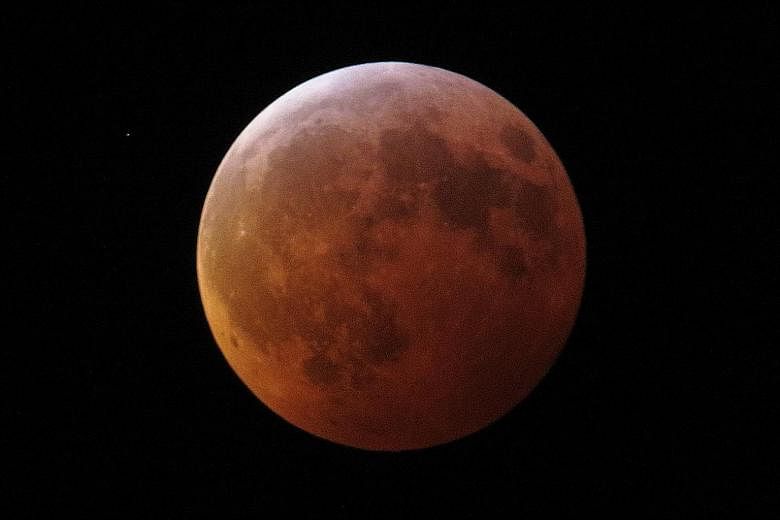LOS ANGELES • Skywatchers howled at the Moon at the Griffith Observatory in Los Angeles when the full lunar eclipse appeared shortly after 8.41pm Pacific time on Sunday (12.41pm yesterday Singapore time) and our celestial neighbour was bathed reddish-orange during a Super Blood Wolf Moon.
"Amazing. As you can see, it's a party atmosphere and everyone is just enjoying the spectacle," said Ms Rosalind Von Wendt.
More than 1,500 people gathered at the observatory near the city's famous Hollywood sign to watch the eclipse.
However, not everyone got to watch the cosmic show. Lunar eclipse parties were cancelled elsewhere due to a flash freeze across central and north-eastern United States. Icy roadways were blamed by astronomers for spoiling the festivities.
In Los Angeles, where the weather was markedly warmer and skies cleared just in time, skywatchers were treated to a full spectacle of the Earth casting its shadow over the Moon's face.
The Moon did not vanish entirely during the total eclipse but, at its height, the entire lunar surface was bathed in a reddish-orange glow that gives rise to the "blood moon" description.
The reddish colour is due to rays of sunlight passing through Earth's dusty, polluted atmosphere as the Moon falls into our planet's shadow.
The shorter, more pliable blue wavelengths of light are scattered outside the Earth's shadow and the longer, less bendable red wavelengths are refracted towards the Moon.
Adding to the visual effect is the fact that the eclipse occurred at a time when the Moon reached a point in its orbit putting it close to Earth, an alignment called a supermoon.
It has also earned the name "wolf moon" because it appears in January, when wolves would howl in hunger outside villages early in US history, according to The Farmers Almanac.
Not everyone on the West Coast had a clear view of the maximum effect of the eclipse. It rained in San Francisco and San Diego had cloudy skies.
Astronomy buffs were urged to watch the eclipse livestreamed online at sites like AstronomersWithoutBorders.org.
In other parts of the US, a wet, wide-ranging snowstorm followed by a deep freeze on Sunday made driving and outdoor activities too hazardous.
Unlike a solar eclipse, which requires eye protection to enjoy the sight safely, no extra measures need to be taken for lunar eclipse watching.
North Americans may get their next glimpse of a blood moon in 2021 along the west coast, and 2022 on the east coast.
For Europeans, the next chance for a glimpse at a lunar eclipse will be in 2022, but the entire continent will not be able to see the totality of a lunar eclipse again until 2029.
REUTERS, AGENCE FRANCE-PRESSE


